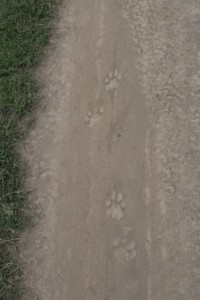I had the most amazing experience last night after I left the Giraffe documentary crew at Sunbird Lodge around 11pm. I received a text: Buffalo killed by 3 lions by Jolai 2 borehole. I was tired, and it was late. I almost decided to just go home but decided to search for the lions. After 30 minutes of unsuccessful searching, I called our operations desk to see if they knew where the kill took place. They said one of our security vehicles was heading to the boma on the south end of the Jolai hill, so I set off to find them. Just as I reached the sirikwa mound, a land cruiser approached from the west. Luckily, they were the oncs that reported the sighting and took me directly to the trough where the young buffalo was killed.
When I finally arrived at the site, the area was heaving with activity – about 15 Jackals, several hyeana and one lioness waiting along the edge of the bush. With the moon’s bright light, I could use my binoculars and could just see two more silhouettes of lionesses. Over the next hour, the hyeanas would cackle and call with deafening sounds just beside my car. When I briefly switched on my lights, I was amazed to see eyes darting everywhere. At one point, there was a thundering sound of hooves rushing toward the trough, and in a could of dust a small herd of very thin buffalo appeared, looking for water. After discovering the trough was empty, they tried to climb on it. Ultimately, they walked away slowly with their heads hung low.
The lionesses continued to sit quietly in the bushes until the hyeana left. Suddenly, one lioness lept out and grabbed the carcass and began to drag it back toward the others. Before reaching the other lionesses, she stopped to have her own feast. She was just a small distance away but directly in front of me. After a while, she decided to share with the other lionesses. Interestingly, the didn’t mind the jackals, at times letting them have a bite or two. No matter how often I see the lions, it always amazes me how large they are compared to the other animals. She picked up the carcass and continued to carry it a little further. Finally, another lioness got up and went over to it. Although it was quite a distance away now, I could still see them through my binoculars. Even now, I am still wondering why the two lionesses stayed away together for so long. Only when the brave one dragged the carcass closer to their spot did one of them move. The other lioness did not make a move forward at all, as far as I could tell. I couldn’t determine if this was the same lioness that is thought to have had cubs. Why else didn’t she move and the other one stayed with her? After they went further into the bush, I decided to leave. By now it was early morning and the scene played over and over in my mind as I drove back to my cottage.





















